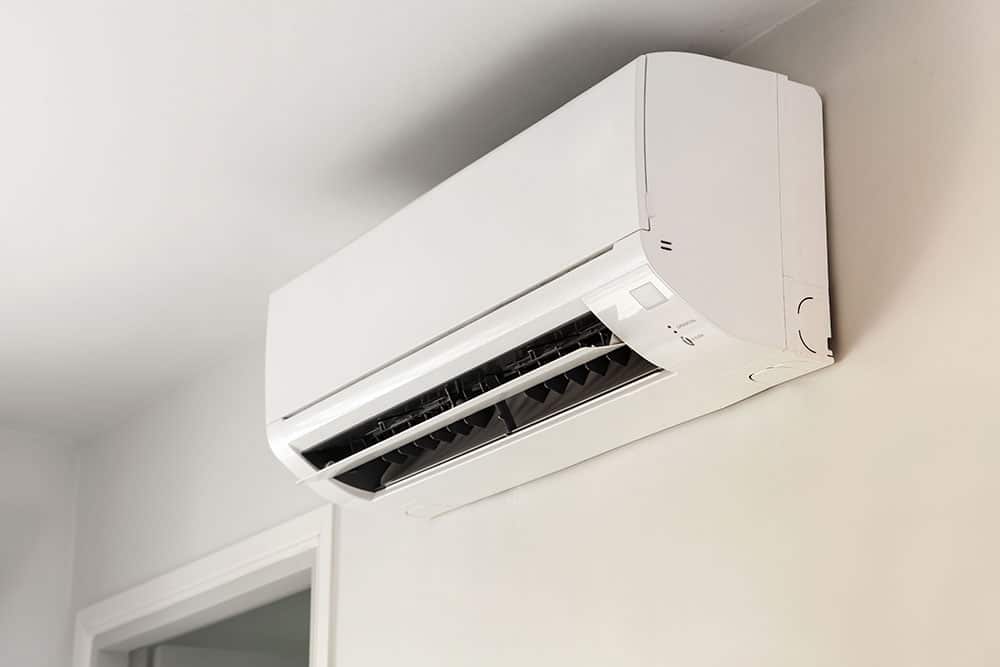New England summers are getting warmer, and to stay comfortable, many homeowners are adding air conditioning to their homes. If your home doesn’t have ductwork, wall-mounted air conditioners are the most convenient choice, but there are a lot of different options.
To select the best wall-mounted air conditioner for your home, you need to look at the options carefully. Here are the nine factors to consider when buying a wall-mounted air conditioner.

1. Types of Wall-Mounted Air Conditioners
One of the first decisions you need to make is about the type of wall-mounted AC that you want. There are three main types of wall-mounted air conditioners:
- Standard wall-mounted air conditioners — These air conditioners go into a sleeve that fits inside a hole cut into an exterior wall of your home. Everything you need is in the unit itself.
- Window air conditioners — Although these air conditioners are designed to go into your window, many homeowners cut a hole and mount them to their walls.
- Wall-mounted ductless air conditioners — Also called heat pumps or mini splits, these wall-mounted ACs connect to an outside condenser, and they can be mounted to interior or exterior walls.
None of these air conditioners require ductwork — this makes them ideal for homes that don’t have existing ductwork. You also don’t have to worry about losing cool air in the ducts as you do with traditional central air conditioning. However, these three types of wall-mounted ACs have very different pros and cons, and many people use these phrases interchangeably so you need to review products carefully when selecting an air conditioner for your home.
Window ACs and standard wall-mounted designs tend to be relatively inexpensive. You can get a unit for a few hundred dollars, and installation is around $200. In contrast, ductless heat pump ACs start at about $4,500 for a single zone with an outdoor condenser, and the price goes up from there.
In exchange for the higher price, you get a much better product. Compared to window ACs, wall-mounted ductless units offer lower energy costs, longer equipment lifespans, a better investment into your home’s value, quieter operation, and more effective comfort.
2. Brand
There are many different brands of wall-mounted ACs. If you want to maximize efficiency and comfort, you shouldn’t look for the cheapest option. Instead, you should look for a wall-mounted air conditioner that can provide you with the most value.
At NETR, Inc, we prefer to work with Mitsubishi wall-mounted ductless units and LG ductless cooling products, and our crew has completed advanced training for installing and maintaining equipment from both of these manufacturers.
However, with over 30+ years in the HVAC business, we have worked with countless other brands as well. We would love to talk with you about the different brands of wall-mounted ACs, but even more importantly, we’d like to help you find the right solution for your home.
3. Cooling Capacity
Regardless of the type of wall-mounted air conditioner that you select, you will need to select the right cooling capacity, which is measured in British Thermal Units (BTUs). As a general rule of thumb, you need about 25 to 30 BTUs per square foot of space. For example, you need about 10,000 BTUs for a 400-square-foot room.
However, you can’t just look at the square footage. You also need to take into account the efficiency of the home. A well-insulated, tightly sealed home will need a lower capacity system than an old drafty home. To ensure you select the optimal capacity for your wall-mounted air conditioner, you should consult with an HVAC specialist.
4. Number of Units
Standard wall-mounted air conditioners are designed to cool relatively modest-sized areas, while ductless ACs can cool larger spaces. You can easily use a single AC unit to cool a single room, but if you want to cool your entire home or even just a floor of your home, you will generally need multiple units.
With a traditional wall-mounted AC, you will need a separate unit for each room of your home. In contrast, you can get a little more creative with a heat pump mini split. For instance, instead of putting an individual air handler in each upstairs bedroom, you could put a ductless AC in the attic and then use ductwork and ceiling registers to deliver the cool air to each of the bedrooms.
If you opt for traditional wall-mounted ACs, the price increases steadily based on the number of units you buy and the price — for instance, five $300 units cost $1,500. With a ductless AC, the price doesn’t increase in the same way. For example, two indoor units are not double the cost of a single indoor unit. Instead, adding additional zones only increases the cost by a fraction of the base price.
That’s because even if you decide to put in multiple indoor AC units, you still only need a single outdoor condenser. An HVAC specialist can help you decide on the optimal number of units for your situation.
Note that each individual AC unit may need a different cooling capacity depending on the size of the room. For instance, an open-plan living room and kitchen generally need a higher capacity unit than a small bedroom or office.
5. Placement of Your Wall-Mounted AC
Once you decide how many wall-mounted AC units you want, you need to decide where to put them. Traditional wall-mounted air conditioners must go on exterior walls, but ductless heat pumps offer more flexibility.
With a ductless AC, you can choose any wall, but ideally, you should mount your AC about two-thirds up the wall or about 4 to 8 inches from the ceiling. You also need to leave about two inches on each side of the unit.
Because wall-mounted ACs feature built-in thermostats, you should mount them in a part of your room that has relatively consistent temperatures. If you put them near a drafty window, too close to an exterior door, or by heat-generating kitchen appliances, they will think it’s hotter than it is and run more often than needed.
6. Style
Standard wall-mount ACs feature a relatively bland style. They come in various shades of beige or white, and they tend to be boxy and industrial looking.
Ductless mini split air conditioners give you more style options. For years, their default color and style were similar to traditional wall-mounted ACs, but new generations come in options such as sleek black, stainless steel, or fun colors. There are also models like the LG Cool Art that look like framed art rather than a wall-mounted air conditioner.
7. Optional Heating
Most standard wall-mounted ACs do not offer optional heating. However, some models — especially those marketed to the hotel industry — come with a built-in electric heater. If you decide on a mini split air conditioner, you can add heating, but this requires a different condenser so you need to decide before you buy.
Adding supplemental heat to your ductless AC only increases the cost by $200 to $400. This adds a heat pump that can heat your home efficiently when it’s about freezing outside, and some people use this to supplement their main heating method.
If you want something that will heat you home efficiently even in sub-zero temperatures, you will need to upgrade to the hyper heat condenser. This adds about $1,000 to $1,500 to your total cost, but ultimately, the final price varies based on the type of equipment and the size of the area you want to cool.
8. Professional Installation or DIY
Once you decide on the type of wall-mounted air conditioner you want, you need to find someone to install it. Window ACs are fairly easy to just put in yourself, but to ensure proper installation, you should hire a professional to help you put in heat pumps or units that require you to cut a hole in your wall.
9. HVAC Company
When choosing someone to install your wall-mounted AC, look for an HVAC company with extensive experience and a long history of customer satisfaction. Ideally, you want a company that will customize a solution for you.
Contact Us About Wall-Mounted Air Conditioners
At NETR, Inc, we have been in the HVAC business for over 30 years. But we’re not just focused on selling HVAC equipment — we’re focused on making our customers comfortable.
When you contact us about wall-mounted air conditioners, we will send a comfort consultant to your home. They will talk with you about your current heating and cooling methods and challenges. Then, they will help you design and select a cooling system that meets your unique needs and your budget.
We will also help you find HVAC financing and apply for rebates that help offset the cost of your wall-mounted ductless unit. Want to be more comfortable this summer? Then, contact us today.

